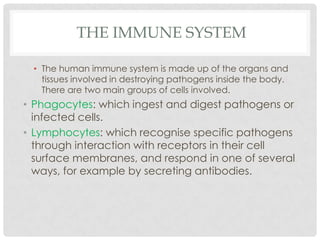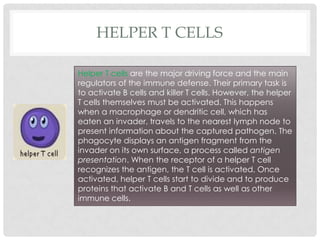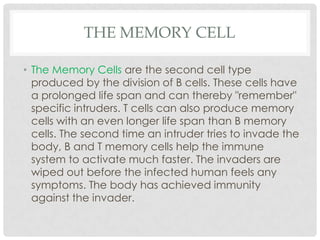The immune system
- 2. THE IMMUNE SYSTEM • The human immune system is made up of the organs and tissues involved in destroying pathogens inside the body. There are two main groups of cells involved. • Phagocytes: which ingest and digest pathogens or infected cells. • Lymphocytes: which recognise specific pathogens through interaction with receptors in their cell surface membranes, and respond in one of several ways, for example by secreting antibodies.
- 3. PHAGOCYTES • This is a group of immune cells specialized in finding and digesting bacteria, viruses, and dead or injured body cells. There are three main types, the granulocyte, the macrophage, and the dendritic cell. The granulocytes often take the first stand during an infection. They attack any invaders in large numbers, and "eat" until they die. The pus in an infected wound consists chiefly of dead granulocytes. A small part of the granulocyte community is specialized in attacking larger parasites such as worms.
- 4. PHAGOCYTES The macrophages ("big eaters") are slower to respond to invaders than the granulocytes, but they are larger, live longer, and have far greater capacities. Macrophages also play a key part in alerting the rest of the immune system of invaders. Macrophages start out as white blood cells called monocytes. Monocytes that leave the blood stream turn into macrophages. The dendritic cells are "eater" cells and devour intruders, like the granulocytes and the macrophages. And like the macrophages, the dendritic cells help with the activation of the rest of the immune system. They are also capable of filtering body fluids to clear them of foreign organisms and particles.
- 5. LYMPHOCYTES • Lymphocytes, unlike phagocytes, act against specific pathogens. Each lymphocyte contains set of genes that codes for the production of a particular type of receptor. We have many million different types, each producing just one type of receptor. • Both B-lymphocytes and T-lymphocytes are made in bone marrow.
- 6. LYMPHOCYTES • Lymphocytes migrate to parts of thelymphatic system such as the lymph nodes, spleen, and thymus. There are two main types of lymphatic cells, T cells and B cells. The lymphatic system also involves a transportation system - lymph vessels - for transportation and storage of lymphocyte cells within the body. The lymphatic system feeds cells into the body and filters out dead cells and invading organisms such as bacteria. • On the surface of each lymphatic cell are receptors that enable them to recognize foreign substances. These receptors are very specialized - each can match only one specific antigen.
- 7. T CELLS • T cells come in two different types, helper cells and killer cells. They are named T cells after the thymus, an organ situated under the breastbone. T cells are produced in the bone marrow and later move to the thymus where they mature.
- 8. HELPER T CELLS Helper T cells are the major driving force and the main regulators of the immune defense. Their primary task is to activate B cells and killer T cells. However, the helper T cells themselves must be activated. This happens when a macrophage or dendritic cell, which has eaten an invader, travels to the nearest lymph node to present information about the captured pathogen. The phagocyte displays an antigen fragment from the invader on its own surface, a process called antigen presentation. When the receptor of a helper T cell recognizes the antigen, the T cell is activated. Once activated, helper T cells start to divide and to produce proteins that activate B and T cells as well as other immune cells.
- 10. THE KILLER T CELL The killer T cell is specialized in attacking cells of the body infected by viruses and sometimes also by bacteria. It can also attack cancer cells. The killer T cell has receptors that are used to search each cell that it meets. If a cell is infected, it is swiftly killed. Infected cells are recognized because tiny traces of the intruder, antigen, can be found on their surface.
- 11. B CELLS ( B-LYMPHOCYTES) • The B lymphocyte cell searches for antigen matching its receptors. If it finds such antigen it connects to it, and inside the B cell a triggering signal is set off. The B cell now needs proteins produced by helper T cells to become fully activated. When this happens, the B cell starts to divide to produce clones of itself. During this process, two new cell types are created, plasma cells and B memory cells.
- 12. THE PLASMA CELL • The plasma cell is specialized in producing a specific protein, called an antibody, that will respond to the same antigen that matched the B cell receptor. Antibodies are released from the plasma cell so that they can seek out intruders and help destroy them. Plasma cells produce antibodies at an amazing rate and can release tens of thousands of antibodies per second. • When the Y-shaped antibody finds a matching antigen, it attaches to it. The attached antibodies serve as an appetizing coating for eater cells such as the macrophage. Antibodies also neutralize toxins and incapacitate viruses, preventing them from infecting new cells. Each branch of the Y-shaped antibody can bind to a different antigen, so while one branch binds to an antigen on one cell, the other branch could bind to another cell - in this way pathogens are gathered into larger groups that are easier for phagocyte cells to devour. Bacteria and other pathogens covered with antibodies are also more likely to be attacked by the proteins from the complement system.
- 13. THE MEMORY CELL • The Memory Cells are the second cell type produced by the division of B cells. These cells have a prolonged life span and can thereby "remember" specific intruders. T cells can also produce memory cells with an even longer life span than B memory cells. The second time an intruder tries to invade the body, B and T memory cells help the immune system to activate much faster. The invaders are wiped out before the infected human feels any symptoms. The body has achieved immunity against the invader.
- 14. B- LYMPHOCYTES
- 15. THANK YOU FOR YOUR ATTENTION















